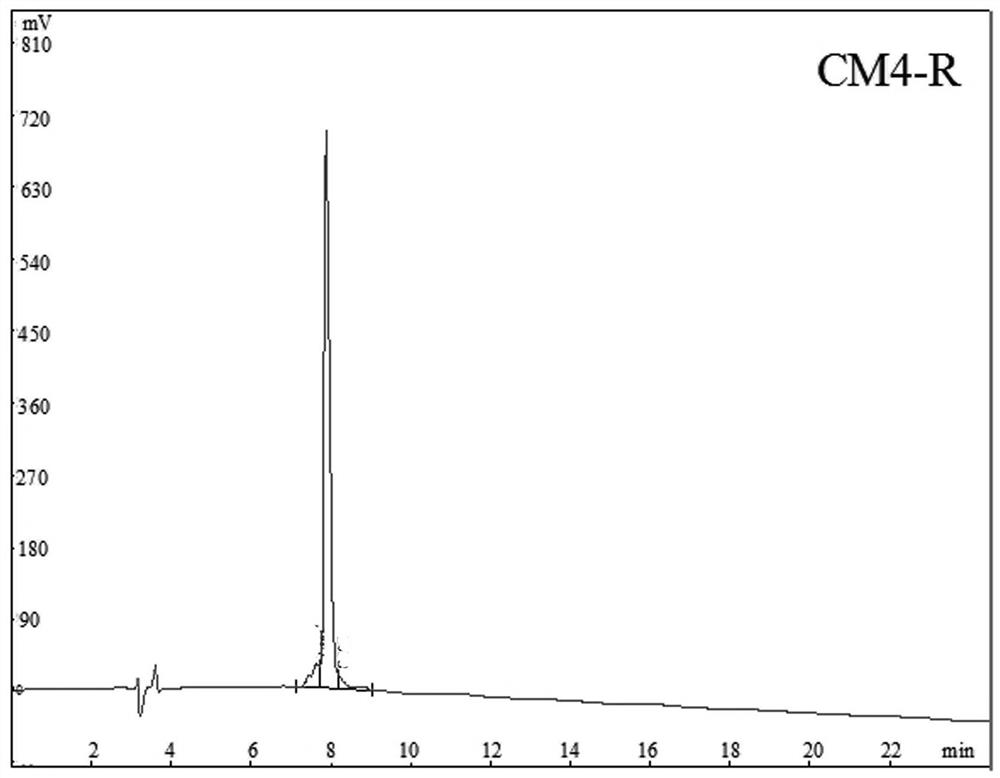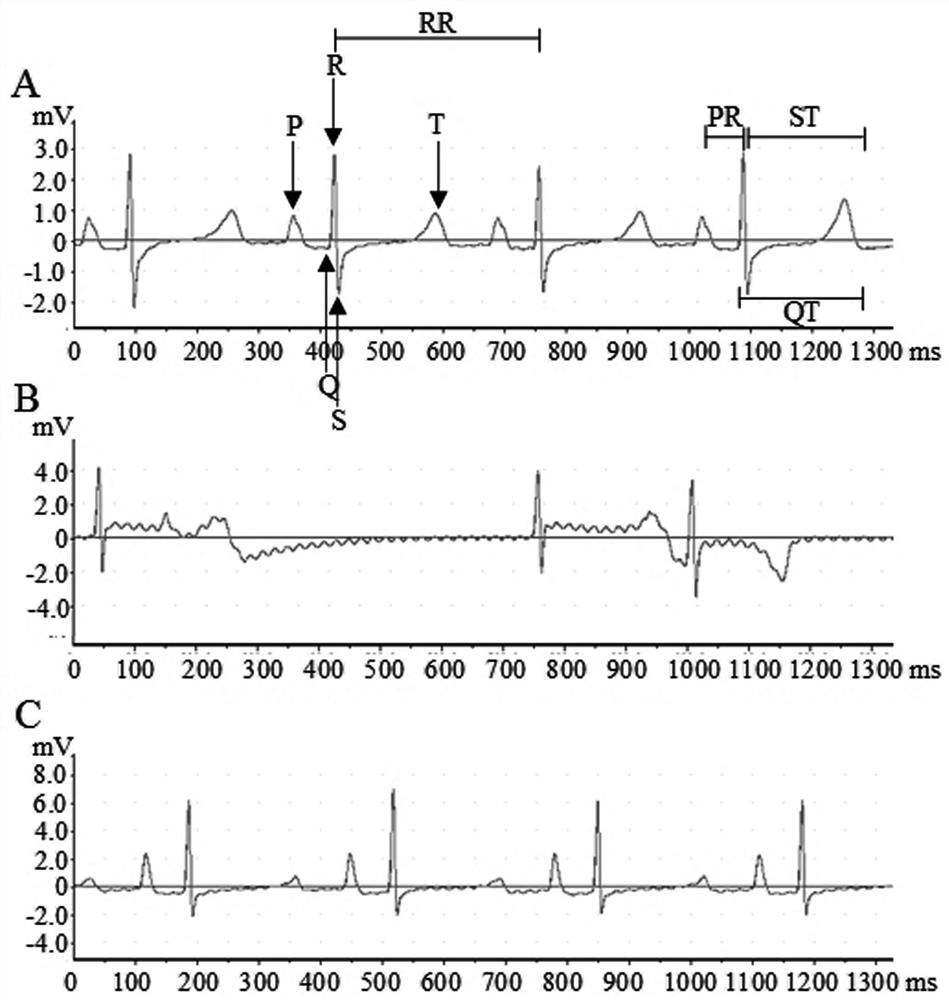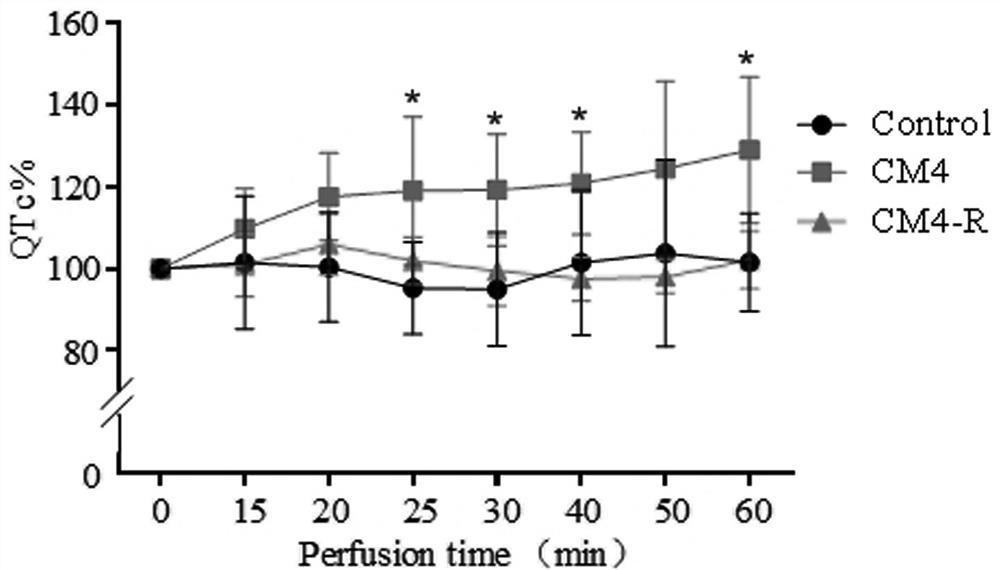Polypeptide for constructing long QT syndrome animal model
A technology of QT syndrome and animal models, applied in the direction of polypeptides, hybrid peptides, and mammalian proteins containing positioning/targeting motifs, which can solve problems such as difficulty in functioning and limitations of biological macromolecules, and the process is simple and effective , easy to obtain, high modeling efficiency
- Summary
- Abstract
- Description
- Claims
- Application Information
AI Technical Summary
Problems solved by technology
Method used
Image
Examples
Embodiment 2
[0045] Example 2 Langendorff perfusion experiment.
[0046] Guinea pigs were injected with heparin (150U / kg / ip) and anesthetized with sodium pentobarbital (40mg / kg / ip). The trachea is connected to an artificial respirator. The aorta was cannulated in situ under artificial respiration. The heart is quickly removed and mounted on a perfusion set. Coronary arteries were retrogradely perfused with Krebs-Henseleit (K-H) solution (5.4mM glucose; 116.0mM NaCl; 3.6mM KCl; 23.0mM NaHCO 3 ; 1.16mM KH 2 PO 4 ; 1.2mM CaCl 2 ; 0.58mM MgSO 4 ; 0.3mM pyruvate; 2.8U L -1 insulin), and the heart was kept in a constant temperature room at 37°C. Coronary perfusion pressure was monitored during aortic cannulation and adjusted to a range of approximately 60-70 mmHg. Place the negative pole of the electrode in the right atrium, and the positive pole in the left ventricle (apex), and record the electrocardiogram (QT interval) using a biological experiment system. In this experiment, the is...
Embodiment 3
[0049] Example 3 GST Pull-Down experiment.
[0050] The concentration of polypeptide CM4 was 1 μg / ul. GST-CT1 (2-4ug) was immobilized on GS-4B, incubated in 300μL system for 4h, 4℃, CM4 concentration gradient (0.1, 0.3, 1.0, 3.0, 10.0μM), system calcium ion concentration (0, 100nM , 10 μM, 2 mM). Calculated by WEBMAXC v2.10 software [Ca 2+ ]. After incubation, with the corresponding Ca 2+ Gently wash the GST-4B-GST-CT1 system twice with buffer, and discard the supernatant for the last time. Then 15μl 5×SDS Loading buffer was used for elution treatment. The supernatant was taken, and the combination was detected by 15% SDS-PAGE electrophoresis. Coomassie brilliant blue R (Coomassie brilliant blue R, CBB) staining and decolorization, such as Figure 4 shown. like Figure 4 In order to successfully detect the combination of CM4 and CT1 ([Ca 2+ ]≈free, 100nM, 10μM, 2mM), correspondingly labeled GST-CT1 and CM4 at molecular weights of 54 and 4kDa. CM4 binds to CT1 with p...
Embodiment 4
[0051] Example 4 Whole animal model experiment.
[0052] The mice were randomly divided into three groups: (1) Control group: 0.9% NaCl; (2) CM4 group: 21 mg / kg CM4; (3) CM4-R group: 21 mg / kg CM4-R. All mice were intraperitoneally injected twice a day at 8:00 and 20:00. After 3 weeks, mice in each group were anesthetized with isoflurane (3%, inhalation). To determine the effect of CM4 on the QT interval in mice, we first detected the ECG using a biological experiment system (Chengdu Taimeng Software Co., Ltd., Chengdu, China). The two ECG electrodes are placed in the standard lead II direction. To calculate the QT interval, the formula for calculating QTc is: Bazett's formula (QTcB[ms]=QT[ms] / (RR[s])1 / 2), such as Figure 5 and Image 6 shown.
[0053] Figure 5 Electrocardiograms were monitored 3 weeks after administration of the polypeptides to the mice. The results showed that the electrocardiogram waveform of the Control group (0.9% NaCl) was stable and the cycle was...
PUM
 Login to View More
Login to View More Abstract
Description
Claims
Application Information
 Login to View More
Login to View More - R&D
- Intellectual Property
- Life Sciences
- Materials
- Tech Scout
- Unparalleled Data Quality
- Higher Quality Content
- 60% Fewer Hallucinations
Browse by: Latest US Patents, China's latest patents, Technical Efficacy Thesaurus, Application Domain, Technology Topic, Popular Technical Reports.
© 2025 PatSnap. All rights reserved.Legal|Privacy policy|Modern Slavery Act Transparency Statement|Sitemap|About US| Contact US: help@patsnap.com



